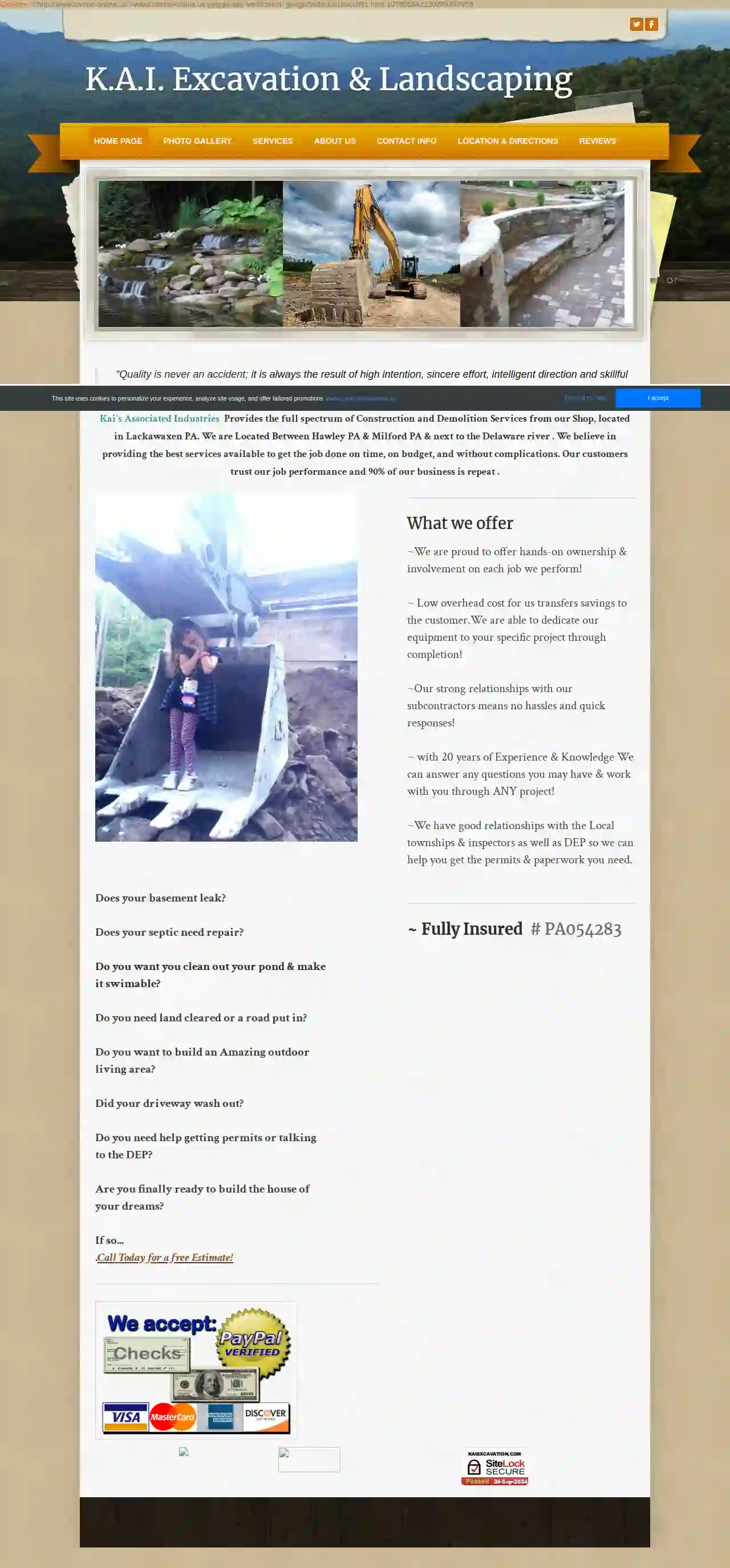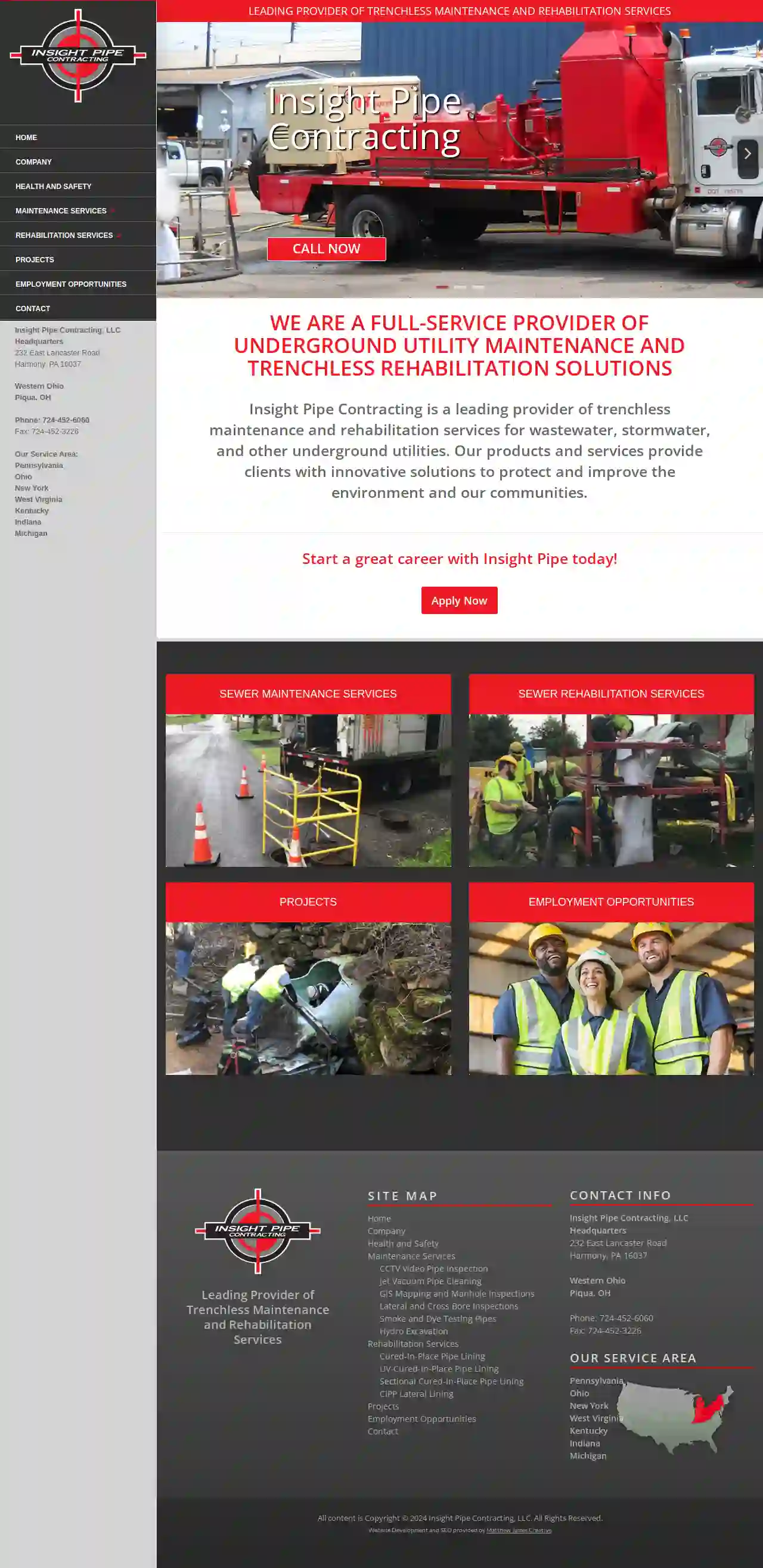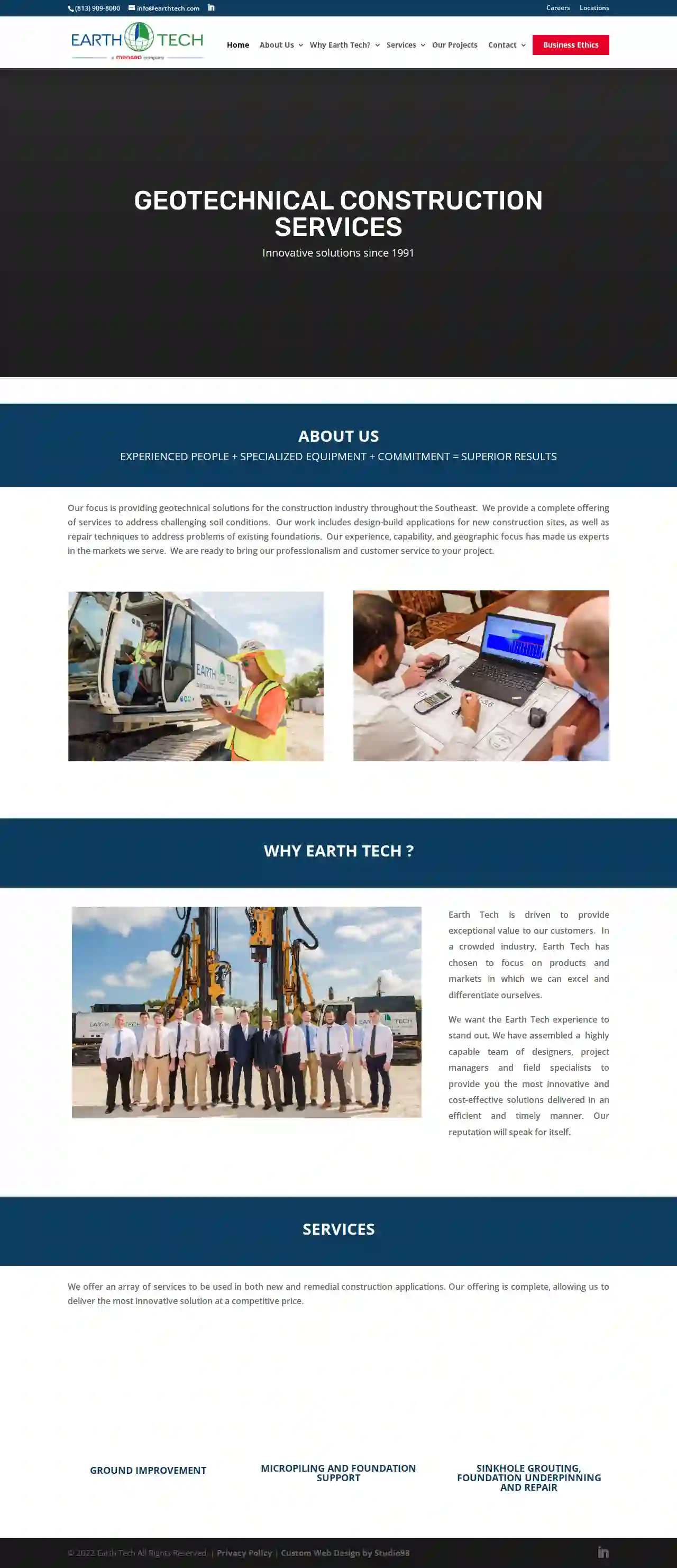Excavation Contractors Whitemarsh
Best Land Excavation in Whitemarsh
Get 3 FREE Land Excavation quotes for your project today! Compare profiles, reviews, accreditations, portfolio, etc... and choose the best deal.

K.A.I. Excavation & Landscaping
4.423 reviewsLackawaxen, USAbout Kai Wicksnes /Owner Operator When did you start your business? I started working in the landscaping /Excavation field right out of High School in 1995. I worked with Heavy Equipment since I was old enough to reach the lever's & Petals. My Best Friend Growing up had a Father in the Excavation business and I learned a lot from him at a very young age. I also came from a long line of hard working men with good work ethics. My dad taught me that learning new trades and learning about the Land was crucial to being a well rounded man. I had a natural proclivity and passion for Excavating & Landscaping since I was a young boy. Before I had my drivers licence neighbors would see me driving my bike with a cart behind it carrying a lawn mower, gas & a rake in tow. Soon I had a small business in the neighborhood and it has grown into what it is today. I have always loved seeing the end result of my work. It gives me great pride to take an area so rough & tumble & make a beautiful waterfall with a pond with free land to run on. What makes you different than other similar businesses in your community? I live in the area that I work ,so I do the best work possible to keep my clients(who are usually my neighbors) happy. I like to drive past a job I did and see kids running in the lawn I created or people sitting around a stone fireplace I built. It is very important to me to continue building a top notch business for my children to someday run. I want Kai's Associated Industries to be known for our great customer service & excellent work. I also have a lot of my own land so I get the majority of my materials right from my property. I am able to REUSE a lot of resources such as tree stumps which we bury until they biodegrade back into the soil. Being very cautious with any land & it's animals, I consider all option's while clearing a large portion of forest. We are a small family business with a big presence With over 20 years of experience & am very knowledgeable about what I do. I am now building a family who is also into landscaping & excavating. From creating landscapes, to operating machinery, to advertising, and book work. I am looking forward to my children working with me & continuing the well established business I poured my heart and soul into. I am a firm Believer that a Family that works together, Stays together . I look forward to see
- Services
- Why Us?
- Gallery
Get Quote
ES Excavation
56 reviewsESExcavation.com, Newtown Square, Pennsylvania, 19073, USExcavation Contractors serving Southeast PA If you are a residential or commercial customer in Southeast PA and the surrounding region, ES Excavation is here to help anytime you need someone to dig in the dirt. We are a full-service excavating contractor, and can also provide you with landscape design and storm water solutions. We aim to complete each of our projects in an efficient and cost-effective way. We don’t cut corners and we always take proper precautions to prevent any potential problems and dangers while striving to ensure that the project is complete on time and under budget. We take the time to meet with all of our clients to ensure that every project is completed to their standards. Providing us with your vision, goals and timeline allows us to do our job even better. Every client we meet and do business with is satisfied with our work. That’s because we work with you, and have a genuine interest in achieving your project goals.
- Services
- Why Us?
- Gallery
Get Quote
Insight Pipe Contracting, LLC
3.912 reviews232 East Lancaster Road, Harmony, 16037, USInsight Pipe Contracting, LLC Insight Pipe Contracting is a leading provider of trenchless maintenance and rehabilitation services for wastewater, stormwater, and other underground utilities. Our products and services provide clients with innovative solutions to protect and improve the environment and our communities.
- Services
- Why Us?
- Gallery
Get Quote
NYC Excavation Contractor
York, USAbout NYC Excavation Contractor NYC Excavation Contractor is a premier provider of excavation services in New York City. With a dedicated team of professionals and top-of-the-line equipment, we deliver unmatched quality in every project we undertake. Our commitment to excellence has earned us a reputation for delivering exceptional results. From clearing land to precision grading, we have successfully completed numerous projects, exceeding client expectations at every turn. Our Commitment Missions & Values Driven by Purpose Our Mission To provide reliable, efficient, and top-quality excavation services to our clients, ensuring their projects are successful and their visions are brought to life. Core Principles Our Values We uphold integrity, professionalism, and client satisfaction as the cornerstones of our operations, fostering relationships based on trust, transparency, and mutual respect. Our Journey Company History Founded in the heart of NYC, NYC Excavation Contractor has grown from humble beginnings to become a trusted name in the industry. With a track record of excellence, we continue to push boundaries and set new standards. Over the years, we have expanded our services, improved our techniques, and embraced innovation to stay at the forefront of the excavation sector. Our journey is defined by continuous growth and a relentless pursuit of perfection.
- Services
- Why Us?
- Testimonials
- Gallery
Get Quote
Earth Tech
York, USAbout Us Earth Tech is a leading provider of geotechnical construction services in the southeastern United States. We specialize in ground improvement, foundation support, and sinkhole remediation. Our team of experienced engineers, project managers, and field technicians is committed to providing our clients with the highest quality services and solutions. Company History Earth Tech was founded in 1991 by Ron Broadrick, a veteran of the geotechnical construction industry with over 40 years of experience. Ron’s vision was to create a company that would provide innovative and reliable solutions to the challenges faced by developers, engineers, and homeowners in Florida and beyond. Since its inception, Earth Tech has grown into one of the largest and most respected geotechnical construction companies in the state, with a reputation for quality, safety, and customer service. Menard Leadership Earth Tech is a proud member of the Menard USA family of companies. Menard USA is a leading provider of geotechnical construction services in North America. With a shared commitment to innovation, quality, and customer service, Earth Tech and Menard USA are working together to provide our clients with the best possible solutions. Why Earth Tech? Earth Tech is the premier choice for geotechnical construction services in the southeastern United States. We offer a wide range of services, including: Ground improvement Foundation support Sinkhole remediation Design and value engineering Project resources We are committed to providing our clients with the highest quality services and solutions. Our team of experienced engineers, project managers, and field technicians is dedicated to exceeding your expectations. Safety & Quality Safety is our top priority. We are committed to providing a safe and healthy work environment for our employees and the public. We have a comprehensive safety program that includes regular training, safety audits, and incident reporting. We are also committed to providing our clients with the highest quality services. We use only the best materials and equipment, and our team of experienced professionals is dedicated to delivering projects on time and within budget. Local Focus and Experience Earth Tech is a locally owned and operated company. We are committed to serving our community and providing our clients with the best possible service. We have a deep understanding of the local soil conditions and regulatory requirements, which allows us to provide our clients with the most effective and cost-efficient solutions. Design and Value Engineering Earth Tech has a team of experienced engineers who can provide design and value engineering services for your project. We can help you to develop the most cost-effective and sustainable solutions for your needs. Project Resources Earth Tech has a wide range of resources available to our clients, including: Experienced engineers Project managers Field technicians Specialty equipment Grout material production We are committed to providing our clients with the resources they need to ensure the success of their projects.
- Services
- Why Us?
- Our Team
- Testimonials
- Gallery
Get Quote
Diggerman Excavating
819 Lake Henry Rd., Lake Ariel, 18436, USLooking for a rock and excavation specialist? You've come to the right place! With extreme attention to detail and a passion for excavating, the Diggerman is the man you need for your project!
- Services
- Why Us?
- Gallery
Get Quote
A&J Site Contracting Corp
57 reviewsYork, USA&J - Quality, Elevation, Transformation From excavation and demolition to installation and maintenance, our skilled team is dedicated to delivering efficient and high-quality results. We pride ourselves on our commitment to customer satisfaction, transparency, and safety. With our extensive services and proven track record, we are confident in our ability to meet and exceed your expectations. Take a look around our website to learn more about our services and see why we are the go-to choice for site contracting. Let's build something amazing together. -we have 20 years of experience From groundwork to grandeur, we build your dream spaces Welcome to A&J Site Contracting Corp! We are a reliable and experienced contracting company dedicated to providing high-quality site construction services. From excavation to demolition, we offer a comprehensive range of services to meet all your site needs. Our team of experts uses the latest techniques and equipment to ensure efficient and timely completion of projects. Browse through our various sections to learn more about our services and see how we can help make your construction project a success. Trust A&J Site Contracting Corp for all your site contracting needs.
- Services
- Why Us?
- Our Team
- Gallery
Get Quote
Liberty Excavators Inc
3.123 reviewsHarrisburg, USWho is Liberty Excavators? Headquartered near Harrisburg, PA, Liberty Excavators is recognized as one of the Mid-Atlantic’s most respected and reliable turnkey site contractors, based on a solid track record spanning over 40 years. Our experienced workforce and state-of-the-art equipment fleet provide us with both the experience and resources to professionally deliver a quality-finished product in the time frame our customers require. Specializations Liberty Excavators specializes in a wide range of projects, including: Turnkey Site Development Warehousing Shopping Centers Industrial Commercial / Residential Site Development Military and Federal Government Healthcare Higher Education Housing Developments Energy (Oil and Gas) Crushing Heavy Equipment Hauling Water / Waste Water Treatment Plants Sewer / Water Utility Line Installation
- Services
- Why Us?
- Gallery
Get Quote
Richmond Testing Lab Inc
52 reviews135 Storer Avenue, Staten Island, 10309, USWelcome to Richmond Testing Lab, Inc. (RTL) Richmond Testing Lab, Inc. (RTL) is a NYC registered and accredited Class 1 Special Inspection Agency. We are also a registered and accredited concrete testing lab. RTL is accredited by IAS and AASHTO as a quality control measure as well. We are fully licensed, registered and insured as required by the NYC Department of Buildings. As an accredited Special Inspection Agency, we employ Engineers, certified Inspectors, and Engineers in training (EIT) as part of our inspection staff. All of our inspectors fully meet or exceed the qualifications required under Appendix A of the Building Department for their assigned inspection category. We provide a pyramid supervisory approach to our inspection staff to ensure that every inspector has a supervisor with exceptional knowledge for each category of inspection for training and guidance. Our function as a special inspection agency is to inspect selected materials, installations, fabrications, erections or placement of components and connections in order to verify compliance with approved construction documents, and reference standards, as required by the Building Code. As a concrete testing lab, we ensure that our staff are fully trained and certified. In addition to the external trainings and certifications we participate in, we have several in-house employees with extensive experience that conduct regular trainings to ensure accuracy and conformance in our testing procedures. The New York City Department of Buildings requires that Special Inspections be conducted for a variety of construction projects. These inspections are performed throughout the construction process and are required in order to obtain a certificate of occupancy with the NYC Department of buildings. These inspections may only be performed by an accredited, registered special inspection agency as per the rules of the Department.
- Services
- Why Us?
- Accreditations
- Gallery
Get Quote
Strouse Excavating and Landscaping
56 reviewsHarrisburg, USRF Strouse Landscape Excavate: Your Trusted Partner for Excavation, Landscaping, and Winter Services in Mount Wolf, PA We pride ourselves on providing exceptional services to residential and commercial clients throughout Mount Wolf, PA. With a commitment to quality, safety, and customer satisfaction, we offer a comprehensive range of services to meet all your property maintenance and improvement needs. From expert excavation to stunning landscape design and reliable winter services, we are your go-to solution for transforming and maintaining your outdoor spaces.
- Services
- Why Us?
- Gallery
Get Quote
Over 22,076+ Excavation Contractors in our network
Our excavation contractors operate in Whitemarsh & surroundings!
ExcavationHQ has curated and vetted the Best Excavation Companies arround Whitemarsh. Find a reliable business today.
Frequently Asked Questions About Excavation Contractors
- Excavations Deeper Than a Certain Depth: This varies by jurisdiction, usually around 5 feet.
- Excavations Near Utilities: Digging near buried utilities (gas, water, electric) often requires permits and utility locates to prevent damage.
- Excavations Affecting Public Property: Projects impacting sidewalks, roads, or other public areas typically require permits.
- Excavations in Environmentally Sensitive Areas: Projects in wetlands, floodplains, or other sensitive areas might need special permits.
- Excavators: Versatile machines with a bucket, arm, and rotating cab for digging, lifting, and moving earth.
- Backhoes: Similar to excavators but with a digging bucket on the back and a loader bucket on the front, ideal for trenching and smaller excavations.
- Bulldozers: Powerful machines with a large blade for pushing earth, clearing land, and leveling surfaces.
- Skid Steers: Compact and maneuverable loaders with various attachments (buckets, forks) for digging, loading, and grading in tight spaces.
- Trenchers: Specialized machines for digging narrow trenches for utilities.
- Dump Trucks: Vehicles for hauling excavated material to disposal sites.
- Hauling to Designated Disposal Sites: Transporting excavated material to approved landfills or recycling centers.
- Recycling or Reuse: If suitable, some excavated soil might be recycled for other projects or reused on-site for landscaping or backfilling.
- Complying with Regulations: Adhering to local and environmental regulations for soil disposal to prevent contamination or illegal dumping.
- Soil Type and Stability: Stable, cohesive soils allow for deeper excavations than loose or unstable soils.
- Groundwater Level: Excavations below the water table require dewatering techniques to manage water intrusion.
- Equipment and Resources: The size and capabilities of excavation equipment influence the achievable depth.
- Safety Regulations: OSHA and other safety regulations impose limitations on trench depths without proper shoring or sloping.
- Project Requirements: The purpose of the excavation (basement, pool, foundation) determines the necessary depth.
Do I need a permit for excavation?
What equipment is used for excavation?
How do you handle soil disposal after excavation?
How deep can you excavate?
Do I need a permit for excavation?
- Excavations Deeper Than a Certain Depth: This varies by jurisdiction, usually around 5 feet.
- Excavations Near Utilities: Digging near buried utilities (gas, water, electric) often requires permits and utility locates to prevent damage.
- Excavations Affecting Public Property: Projects impacting sidewalks, roads, or other public areas typically require permits.
- Excavations in Environmentally Sensitive Areas: Projects in wetlands, floodplains, or other sensitive areas might need special permits.
What equipment is used for excavation?
- Excavators: Versatile machines with a bucket, arm, and rotating cab for digging, lifting, and moving earth.
- Backhoes: Similar to excavators but with a digging bucket on the back and a loader bucket on the front, ideal for trenching and smaller excavations.
- Bulldozers: Powerful machines with a large blade for pushing earth, clearing land, and leveling surfaces.
- Skid Steers: Compact and maneuverable loaders with various attachments (buckets, forks) for digging, loading, and grading in tight spaces.
- Trenchers: Specialized machines for digging narrow trenches for utilities.
- Dump Trucks: Vehicles for hauling excavated material to disposal sites.
How do you handle soil disposal after excavation?
- Hauling to Designated Disposal Sites: Transporting excavated material to approved landfills or recycling centers.
- Recycling or Reuse: If suitable, some excavated soil might be recycled for other projects or reused on-site for landscaping or backfilling.
- Complying with Regulations: Adhering to local and environmental regulations for soil disposal to prevent contamination or illegal dumping.
How deep can you excavate?
- Soil Type and Stability: Stable, cohesive soils allow for deeper excavations than loose or unstable soils.
- Groundwater Level: Excavations below the water table require dewatering techniques to manage water intrusion.
- Equipment and Resources: The size and capabilities of excavation equipment influence the achievable depth.
- Safety Regulations: OSHA and other safety regulations impose limitations on trench depths without proper shoring or sloping.
- Project Requirements: The purpose of the excavation (basement, pool, foundation) determines the necessary depth.